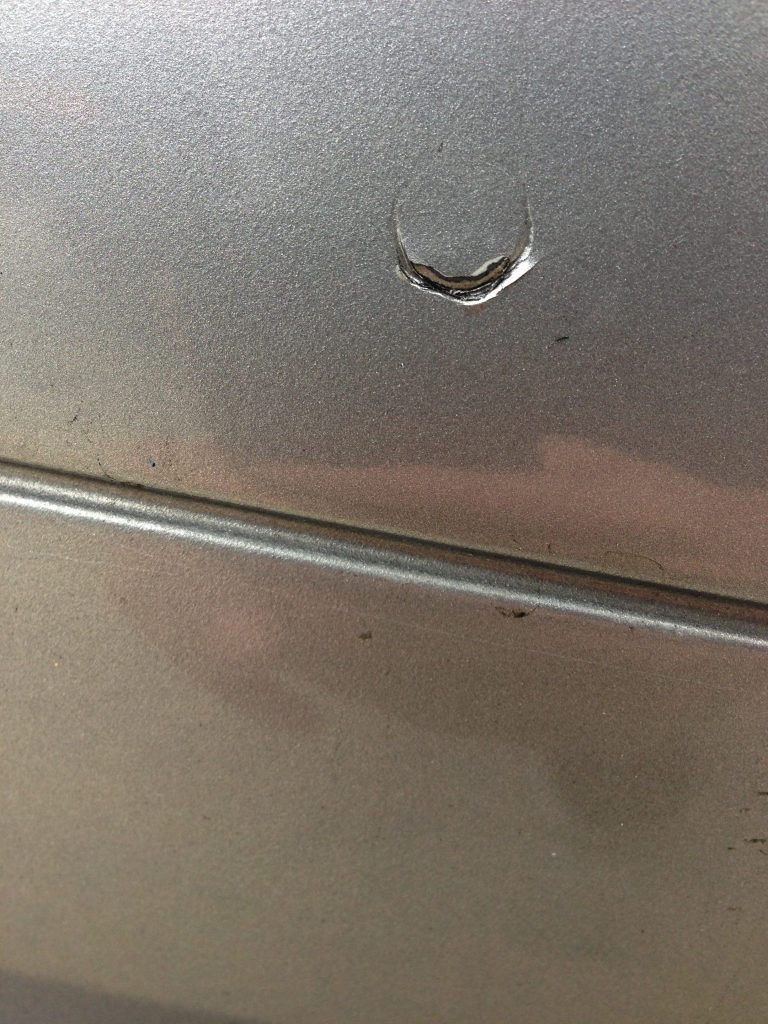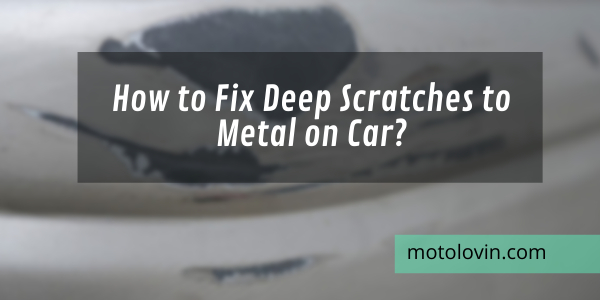To fix deep scratches on metal car surfaces, use touch-up paint that matches the vehicle’s color. Buff out the scratches and apply the paint evenly.
Maintaining the appearance of your car is crucial for its overall aesthetics and value. Deep scratches on the metal surface can be unsightly and can lead to rust if left untreated. Fortunately, there are steps you can take to address these scratches and restore your car’s appearance.
By following the right techniques and using the proper materials, you can effectively fix deep scratches on your car’s metal surfaces. This guide will provide you with the necessary steps to repair these imperfections and keep your car looking its best.
Assessment Of Damage
Fixing deep scratches on metal car surfaces can be challenging, but with careful assessment of the damage and proper techniques, it is possible to restore the appearance.
When your car’s metal exterior is marred by deep scratches, it’s essential to assess the extent of the damage before proceeding with any repairs. By carefully evaluating the scratches, you can determine the appropriate fix and ensure a seamless restoration. This assessment involves identifying the depth of the scratch and checking for signs of rust or corrosion. Let’s delve into each of these aspects to help you understand how to best address those unsightly scratches.
Identifying The Depth Of The Scratch
Before you can decide on the best course of action, it’s crucial to determine the depth of the scratch on your car’s metal surface. This helps establish whether the scratch solely affects the clear coat or penetrates deeper into the paint and even the metal itself. Here’s a step-by-step guide to help you identify the depth:
- Start by running your finger carefully over the scratched area, examining the texture and depth.
- If the scratch is shallow and you can barely feel it, it is likely confined to the clear coat, which can often be fixed with simpler solutions.
- If you can feel the scratch with your fingernail, it is more severe and may have penetrated through the clear coat and reached the paint layer.
- In cases where the scratch feels even deeper, reaching the metal surface, it requires more extensive repair work.
By identifying the depth of the scratch, you can gauge the complexity of the fix, ensuring you choose the appropriate methods and products for optimal results.
Checking For Signs Of Rust Or Corrosion
Alongside determining the depth of the scratch, it’s also essential to inspect the affected area for any signs of rust or corrosion. In some instances, particularly if the scratch has been left untreated for an extended period, moisture and exposure to the elements can result in rust formation.
To check for signs of rust or corrosion:
- Thoroughly clean the scratched area with soap and water, ensuring any dirt or debris is removed.
- Inspect the surface for any discoloration, especially reddish-brown patches or rough spots, which are indications of rust or corrosion.
- If you notice any signs of rust, it’s crucial to address them promptly to prevent further damage to your car’s metal body.
By checking for signs of rust or corrosion, you can take appropriate actions to mitigate any potential long-term damage. This step ensures that your efforts to fix the deep scratches will not be hampered by underlying corrosion.
Preparation For Repair
To repair deep scratches on a metal car, start by cleaning the affected area with soap and water. Next, sand down the scratch, apply a primer, and then use touch-up paint to fill in the damaged area. Finish by buffing the paint to blend it seamlessly with the rest of the car’s surface.
Gathering Necessary Materials
Before starting, ensure you have all required materials on hand.
- Paint matched to your car’s color
- Fine-grit sandpaper
- Primer
- Clear coat
- Microfiber cloths
- Protective gloves
Cleaning The Damaged Area
Begin by thoroughly cleaning the scratched area of your car.
- Use a mild car detergent and water to clean the surface.
- Dry the area completely with a microfiber cloth.
- Remove any wax deposits using a wax remover.
Applying The Fix
To effectively address deep scratches on car metal, you can use scratch filler and touch-up paint.
Using Scratch Filler For Deep Scratches
- Apply a small amount of scratch filler directly onto the scratched area.
- Spread the filler evenly over the scratch using a clean cloth or applicator.
- Allow the filler to dry completely as per the manufacturer’s instructions.
- Once dry, gently sand the area to ensure a smooth surface.
Applying Touch-up Paint
- Clean the scratched area thoroughly to remove any dirt or debris.
- Shake the touch-up paint bottle well to ensure proper mixing.
- Use a fine-tipped brush to carefully apply the paint to the scratch.
- Allow the paint to dry completely before applying additional coats if needed.
By following these steps, you can effectively fix deep scratches on your car’s metal surface with scratch filler and touch-up paint.

Credit: haynes.com
Polishing And Finishing
To address deep scratches on a car metal surface, the process of polishing and finishing is crucial. By meticulously buffing out imperfections, the metal can be restored to a sleek and pristine appearance, enhancing both the aesthetic appeal and value of the vehicle.
Sanding The Repaired Area
If you have successfully applied touch-up paint and primed the deep scratches on your car’s metal surface, the next step is to sand the repaired area to achieve a smooth finish. Sanding helps in removing any rough edges or imperfections left behind by the touch-up paint and priming process.
Here is a step-by-step guide on how to sand the repaired area:
- Start by preparing a sanding block or sandpaper with a grit level of around 2000.
- Wet the sandpaper or sanding block with water and gently sand the repaired area in a back-and-forth motion.
- As you sand, periodically rinse the area with water to remove any debris or paint residue.
- Continue sanding until the repaired area feels smooth to the touch and blends seamlessly with the rest of the car’s surface.
- Once you have achieved the desired smoothness, wipe the area clean with a soft cloth or towel.
Applying Clear Coat
A crucial step in the polishing and finishing process is applying a clear coat to protect the repaired area and give it a glossy look. The clear coat acts as a shield against further damage and adds a professional touch to your car’s appearance.
Follow these steps to apply clear coat:
- Select a high-quality automotive clear coat spray that matches the finish of your car.
- Prepare the area by masking off any surrounding surfaces that you don’t want to be sprayed.
- Hold the clear coat spray can approximately 8-12 inches away from the repaired area.
- Apply the clear coat in thin, even layers, using smooth and overlapping motions.
- Allow each layer to dry completely before applying the next one.
- After applying the final coat, let it dry for the recommended time specified on the clear coat product.
Remember to work in a well-ventilated area and follow the instructions provided by the clear coat manufacturer for best results.
Final Touches
Revive your car’s metal surface by addressing deep scratches with these final touches. Follow our step-by-step guide to restore your car’s shine and protect it from rust. With simple techniques and the right products, you can easily make your car look brand new again.
Buffing And Blending The Area
Once the deep scratches have been filled and sanded, it’s time to focus on buffing and blending the affected area to seamlessly integrate the repair with the rest of the car’s surface.
First, apply a buffing compound to the repaired area using a clean, soft cloth or a buffer pad. This will help to remove any remaining imperfections and smooth out the surface.
Next, utilize a car polish to further enhance the shine and blend the repaired area with the rest of the car. Carefully buff the entire affected area, ensuring that the transition between the repair and the surrounding paint is virtually undetectable.
Assessing The Finished Repair
After the buffing and blending phase, it’s essential to thoroughly assess the finished repair to ensure that the deep scratches are now practically invisible. Here’s what to look for:
- Check the repaired area from various angles and under different lighting conditions to pinpoint any remaining imperfections.
- Run your fingers over the repaired area to detect any rough spots or inconsistencies.
- Compare the repaired section with the rest of the car’s surface to ensure a seamless integration.
If the finish appears flawless and the deep scratches are no longer apparent, congratulations! Your car’s metal surface has been successfully restored.

Credit: www.wikihow.com
Preventive Measures
Preventive measures play a crucial role in maintaining the appearance and integrity of your car’s metal surface. By adopting certain protective and maintenance practices, you can effectively prevent deep scratches and prolong the life of the repair work.
Protecting The Repaired Area
After eliminating deep scratches from the metal on your car, it’s important to take steps to protect the repaired area from potential damage. One way to achieve this is by applying a high-quality protective coating. This coating acts as a barrier, shielding the metal from scratches, dings, and environmental elements that could cause further damage. Regularly inspect the coated area for any signs of wear or damage.
Regular Maintenance Practices
- Wash your car regularly to remove dust, dirt, and debris that can scratch the metal surface.
- Use a soft microfiber cloth and gentle cleaning products to avoid abrasive damage to the metal.
- Apply wax or sealant to the metal surface to create an extra layer of protection against scratches and environmental damage.
- Avoid parking in areas with heavy foot traffic or where debris is likely to be kicked up onto the car.

Credit: 5series.net
Frequently Asked Questions On How To Fix Deep Scratches To Metal On Car
How Can I Fix Deep Scratches On My Car?
To fix deep scratches on your car, start by cleaning the area, then sand the scratch, apply primer, paint, and clear coat. Finally, polish the area to blend the repair with the rest of the car’s surface. It’s best to seek professional help for severe scratches.
What Are The Best Products For Repairing Car Scratches?
High-quality car scratch repair kits, including sandpaper, primer, paint, and clear coat, are suitable for fixing metal car scratches. Ensure the products match your car’s color. Professional automotive paint touch-up services are also advisable for a flawless finish.
Is It Necessary To Seek Professional Help For Deep Car Scratches?
While minor scratches can be fixed at home, deep scratches require professional expertise. Automobile body shops have the necessary tools and skills to effectively repair deep car scratches, ensuring a seamless finish without causing further damage to the car’s metal surface.
Conclusion
Repairing deep scratches on a car’s metal surface is a task that requires attention to detail and the right tools. By following the step-by-step guide provided in this blog post, you can effectively restore your car’s appearance and protect it from further damage.
Remember to clean and prep the area before applying the appropriate touch-up paint or filler, and follow up with a protective top coat for long-lasting results. With patience and care, you can make your car look as good as new!
